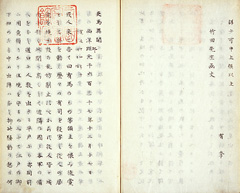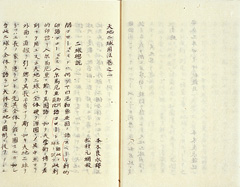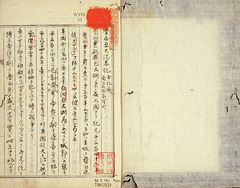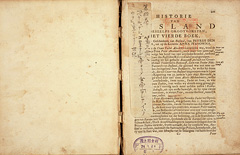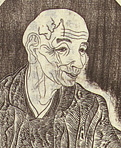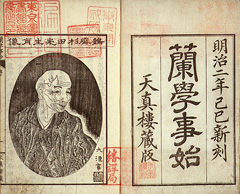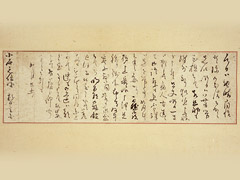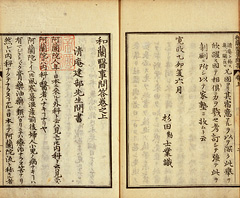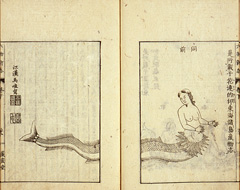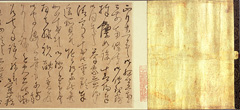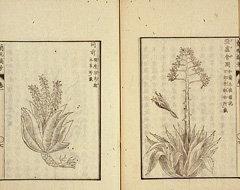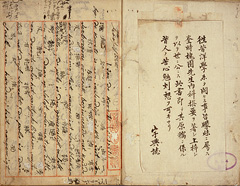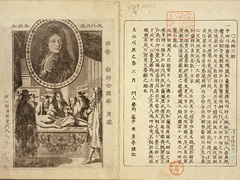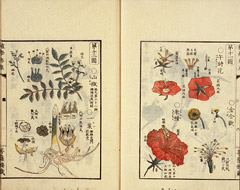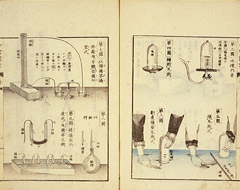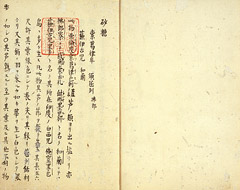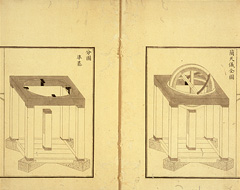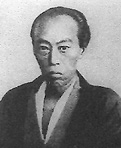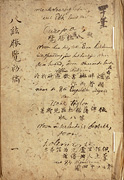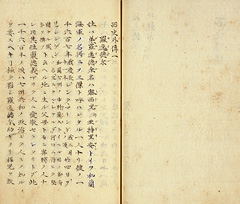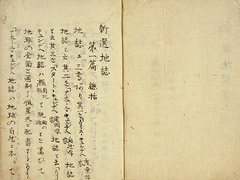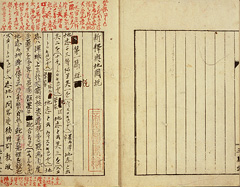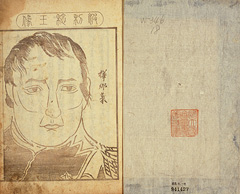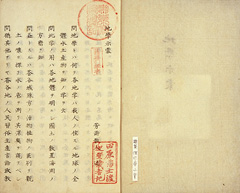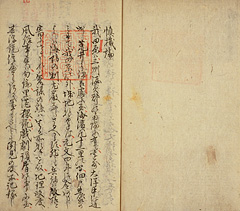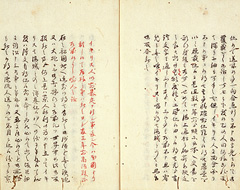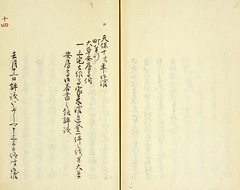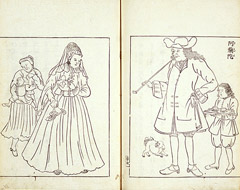This is a Japanese translation by Nagasaki Dutch interpreter Yoshio Gonnosuke (1785-1831) of the excerpts from the Factory's journal. Excerpts were made by the chief of the Dutch Factory H. Doeff (1777-1835) of the portion of N. Coeckebacker's journal covering the Shimabara Rebellion (1636-1637). N. Coeckebacker was Dutch Factory chief in Hirado. During the Shimabara Rebellion, the Dutch factory at Hirado was requested by the Shogunate government to send a ship, which bombarded the Hara Castle held by the rebels from the sea, and thus contributed to suppressing the rebellion. There is a possibility that 'Tenba' is a compound word of 'Amakusa' and 'Arima'.
Home | Part 2: View by Topics | 2. Activities of Dutch Studies
Part 2: View by Topics
2. Activities of Dutch Studies
One of the scholarly subjects during the Edo period was Western learning and technology transmitted to Japan via the Dutch language, and so Dutch studies existed to study this information. These studies focused mainly on the natural sciences, such as medicine, astronomy, herbal, natural history, botany, chemistry, mapmaking and calendars.After initially concentrating on learning the Dutch language by Dutch interpreters in Nagasaki, the study of herbal was promoted under Tokugawa Yoshimune, and the import of books from the Netherlands was encouraged. Aoki Kon'yo and Noro Genjo were ordered by Yoshimune to study Dutch, and this all added momentum to Dutch studies. This momentum was further strengthened by the promotion of policies to encourage new industries when Tanuma Okitsugu became the Roju (senior councilor). Domain lords that liked the Netherlands, called "ranpeki," such as Kutsuki Masatsuna, lord of the Fukuchiyama Domain, and Shimazu Shigehide, lord of the Satsuma Domain, began to appear.
A major innovation of the Dutch studies boom was the translation and publishing of Kaitai shinsho in 1774 and the introduction of Western medicine by Maeno Ryotaku, Sugita Genpaku, Nakagawa Jun'an and others. During the Edo period, the knowledge of various subjects was passed down within the family and Dutch studies were no different; this field of study was propagated by talented pupils. The chapter covers the activities of the Dutch studies scholars and the books they wrote.
Dutch Interpreters
Tenchi nikyu yoho.
By Wiruremu Yohan Burau. Tr. by Motoki Ryoei. Rev. by Matsumura Genko. Ms. 4 v. <W383-10>
This is a Japanese adapted translation of Tweevoudigh onderwiis van de hemelsche en aerdsche globen (1666). Original Dutch book is a handbook explaining terrestrial and temporal globes, written by the Dutch mapmaker Willem Janszoon Blaeu, which was translated into Latin and published in 1633 under title Institutio astronomica de usu globorum et sphaerarum caelestium ac terrestrium), which in turn was translated into Dutch. Nagasaki interpreter Motoki Ryoei translated this Dutch book in 1774. This is one of the oldest works explaining the Copernican theory in Japan.
Garasu seiho shusetsu.
By Boisu et al. Tr. by Baba Sajuro. Ms. 1 v. <W387-N8>
This is a book on glassmaking translated by Nagasaki interpreter Baba Sajuro (1787-1822) from selected Dutch sources by E. Buys and N. M. Chomel at the order of the Shogunate government. The manuscript was completed in 1810, but was not published. It was the most advanced publication on glassmaking during the Edo period.
Maeno Ryotaku
Rosia daito ryakki; Teiki hen.
Tr. by Maeno Ryotaku. Ms. 1 v. <W335-21>
This book is on the history of Russian czars, and was edited by Maeno Ryotaku. It is based on the Dutch book Oude en nieuwe staat van 't Russische of Moskovische keizerryk (Utrecht, 1744), but our copy that was belonged to Yoshio Kogyu is wanting the first half (see the next entry). This Roshia daito ryakki: Teiki hen is bound with the Roshia teio yori shina pekin teito eno chokushi dochu nikki, which is translated by Yoshio Kogyu.
Oude en nieuwe staat van 't Russische of Moskovische keizerryk.
3-4. dl.:4-6 boek. Utrecht: J. Broedelet, 1744. 1 v. <蘭-567>
This book, 'Old and new history of the Muscovite Empire of Russia', was the basis of Roshia daito ryakuki: Teiki hen edited by Maeno Ryotaku, and as shown by the note 'Koozack' (Kosaku) on the cover, it has been belonged to Yoshio Kogyu. However, our copy is wanting the first half, covering the period from ancient Russia to Peter the Great. The Hokkaido University Library has a complete set. Belonged to the Shogunate government.
Gaiso Maeno Ranka sensei seiyo kinju syashin.
Painted by Maeno Ryotaku. 2 pictures in 1 roll. <WA31-15>
This is a hanging picture that contains the two sheets of foreign animal pictures drawn by Maeno Ryotaku. Ryotaku was a person of note in Edo as a Dutch studies scholar and he was interested in zoology as well as medicine and was well versed in the Dutch language works on zoology. Belonged to the Ito Collection (Japanese).
Sugita Family
|
Sugita Genpaku (1733-1817) He is the son of Obama Domain physician Sugita Hosen, and he too was an Obama Domain physician. Together with Maeno Ryotaku and Nakagawa Jun'an, he translated Anatomische Tabellen, and Kaitai Shinsho was published in 1774. At the private school Tenshinro, he taught the pupils such as Otsuki Gentaku and others. Later on, the Sugita family produced many noted people in Dutch studies including Sugita Hakugen (Kin) who inherited leadership of the family, Ryukei (Yo) who established a separate branch of the family, and his son Seikei (Shin), among others. |
Rangaku kotohajime.
By Sugita Genpaku. Tokyo: Tenshinro, 1869. 2 v. in 1. <YDM52922>
This is a memoir by Sugita Genpaku about the pioneering days of Dutch studies including the difficulties of translating and publishing Kaitai Shinsho. He completed it in 1815. It was passed around as a manuscript book with such titles as Ranto kotohajime and Oranda kotohajime till the end of the Edo period. This book was published as a woodblock print by Fukuzawa Yukichi and Sugita Renkei, the grandson of Genpaku. Thereafter, it became commonly known as Rangaku kotohajime.
Sugita Isai sensei zo Koishi Taigu sensei toku.
Written by Sugita Genpaku in 1787. Autograph. 1 roll. <WA47-8>
Koishi Taigu (1743-1809) went by the alias Genshun, with Taigu being a pen name. He was a physician who worked in Kyoto and Osaka and conducted a human dissection in 1783. He was friends with Genpaku and Gentaku, and this is a letter sent from Genpaku on April 13, 1787, while Koishi was staying in Edo. It discusses a request to Koishi for a house call. Belonged to the medical historian Fujikawa Yu.
Oranda iji mondo.
By Takebe Seian and Sugita Genpaku. Edited by Sugita Hakugen. Toto: Suharaya Zengoro, 1795. 2 v. in 1. <210-248>
Ichinoseki Domain physician Takebe Seian (1712-1782) wrote a letter of questions regarding Dutch medicine in 1770, and entrusted it to his pupil Kinudome Hoken. This letter was given to Sugita Genpaku of Edo in 1773 and Genpaku, who was interested in Seian's questions, wrote an answer, and thereafter the two corresponded about Dutch medicine. This book is a collection of two-way correspondence consisting of two letters of questions from Seian and two letters of answers from Genpaku. Seian's fifth son, Kin, became Genpaku's adopted son (Hakugen) and his third son Ryosaku, and pupil Otsuki Gentaku, also studied under Genpaku.
Otsuki Family
The Otsuki family served as domain physicians for the Ichinoseki Domain, and Otsuki Gentaku learned Dutch studies and later became the physician for his head domain, the Sendai Domain. The Otsuki family produced many scholars in Dutch studies and other subjects, and Gentaku's first son, Genkan, became a Dutch studies scholar, his second son, Bankei, became a Confucian; and his grandson, Gento, became a Dutch studies scholar. The family produced many other scholars including Bankei's second son, Shuji (Joden), who was a Western studies history researcher and wrote Yogaku nenpyo (Western studies chronology), and Shuji's younger brother, Fumihiko, who was a famous Japanese literature scholar who wrote Genkai.
|
Otsuki Gentaku (1757-1827) Otsuki Gentaku was the son of Otsuki Genryo. His name was Shigekata and his pen name was Bansui. He learned medicine from Takebe Seian, and later learned Dutch studies from Sugita Genpaku and Maeno Ryotaku. He opened the Rangakujuku (private Dutch studies school) Shirando while working as a physician for the Sendai Domain. In 1811 he worked as a translator at Tenmonkata (Astronomy Bureau) and worked on the translation of N. M. Chomel's encyclopedia. In addition to the works introduced here, he wrote many other books including Rangaku kaitei, Ransetsu benwaku, and Jutei Kaitai shinsho. |
|
Otsuki Genkan (1785-1837)
Genkan was the first son of Otsuki Gentaku. He learned Dutch in Nagasaki from Shizuki Tadao. In January 1824, he was assigned to work on Japanese translations of foreign books at the Shogunate government's Tenmonkata. He wrote such works as Rangaku han and Seion hatsubi.
Rokumotsu shinshi.
Tr. and edited by Otsuki Gentaku. Rev. by Sugita Hakugen. Naniwa: Kenkado, 1786? 2 v. <特1-104>
The book covers the six substances as sword of narwhale, saffron, nutmeg, mummies, agaric (larch polypore), and mermaid, which were major medicines of interest to Dutch studies scholars. This was researched based on descriptions from Dutch books. An illustration is included for each of the substances and the illustration of narwhale was made by J. Jonston and that of nutmeg by R. Dodoens. Belonged to the Shirai Collection (Japanese).
Otsuki Gentaku jihitsu shokan.
Written by Otsuki Gentaku. Autograph. 1 roll. <WA25-83>
This is a letter from Otsuki Gentaku to Ema Shunrei (Genkyo, 1747-1838) who was a Dutch medicine physician to the Ogaki Domain. Ema learned Dutch studies from Sugita Genpaku and Maeno Ryotaku. The letter gives thanks for the assistance received after the fire at the end of 1796, states that Genpaku is busy as usual, states that Ryotaku is in good health, and describes the activities of the Dutch studies scholars.
Ran'en tekiho. Shohen.
Tr. by Otsuki Gentaku. Rev. by Otsuki Genkan and Yamamura Saisuke. Osaka: Kawachiya Tasuke, etc., 1817. 3 v. <特1-216>
This is a collection of notes by pupils of the answers that Otsuki Gentaku gave to the questions from pupils and acquaintances, describing Western medications, products, etc. This was originally diffused as manuscripts, but there was strong demand for it to be published, so this 1st pt. was published in 1817. It describes the 19 items including aloe, etc., and is written in kanbun (classical Chinese). This book includes the contents of following parts, but they were not published.Belonged to the Shirai Collection (Japanese).
Udagawa Family
This family produced Genzui, who was the son of Tsuyama Domain physician Udagawa Michinori, and who studied Dutch studies. His adopted son Genshin and Genshin's adopted son Yoan and Yoan's adopted son Kosai all became Dutch medicine physicians and Dutch studies scholars.
Seiyo naika senyo. 1-2. (Ushi hikyu, v. 1)
By Yohanesu de Goruteru. Tr. by Udagawa Genzui. Autograph. 1 v. <WA21-14>
From 1793-1810, Udagawa Genzui published Seisetsu naika senyo (total of 18 volumes), which was the first translation in Japan of Western internal medicine, but the original work in Dutch, Gezuiverde geneeskons (Amsterdam, 1744), was written by Johannes de Gorter. For this book Genzui transcribed the chapters 1-3 "hoofdstuk" in the original work, and translated parts of this into Japanese.This notebook corresponds to the volumes 1 and 2 of published Seisetsu naika senyo. In 1822, Udagawa Genshin and colleagues published Zoho jutei Naika senyo. On the flyleaf is mounted an annotation by Udagawa Kosai (third son of Iinuma Yokusai, adopted by Udagawa Yoan, 1821-1887).
Ihan teikozu.
Tr. by Udagawa Genshin. Etched by Aodo. S.l.: Fuundo, 1808. 1 v. (accordion fold) <WB38-6>
Rigaku hatsubi.
By Isaku Tirion. Tr. by Udagawa Yoan. Written in 1825. Autograph. 1 v. <WA21-27>
Shokugaku keigen.
By Udagawa Yoan. Edo: Suharaya Ihachi, etc., 1837. 3 v. in 1. <W392-N1>
The first edition was published in 1834. It is an introduction to botany written in kanbun (classical Chinese). It describes Linnaean taxonomy using 24 classes to classify plants by their roots and foliage and even covers such subjects as physiology and biochemistry. The illustrations from various Dutch books were used. It accompanies Shokugaku keigen zu with 21 color woodblock prints. Belonged to the Daigaku Nanko, the Education Ministry, and the Education Museum.
Seimi kaiso.
By Henri. Rev. by Toromusudorufu and Ipei. Tr. from Dutch by Udagawa Yoan. Edo: Suharaya Ihachi, 1837-47. 7 v. <特1-855>
This is an introduction to chemistry. 'Seimi' is the pronunciation of chemie, the Dutch word for chemistry. J. B. Trommsdorff made a German translation and enlargement of the work Elements of experimental chemistry (1799) by William Henry, which was translated into Dutch and enlarged by A. Ijpeij.The Japanese translation was made from this Dutch book. The work was produced by referencing not only of Ijpeij's Dutch edition, but also Dutch translations of the works of A. L. Lavoisier to systematically introduce Western chemistry. Belonged to the Shirai Collection (Japanese).
Seishoku zensho.
By Udagawa Yoan. Autograph. 3 v. <WA21-22>
This work establishes a species, name, shape, investigation, etc. for plants, such flowering cherries, based on Western botany and explains them. This includes a relatively well compiled collection of entries and notes. Belonged to the Ito Collection (Japanese).
[Udagawa Yoan meishi.] (Appendix to Naika senyo)
1 sheet. <WA21-14>
Takahashi Family
Takahashi Yoshitoki (1764-1804) studied calendar science under Asada Goryu, and worked at Tenmonkata (Astronomy Bureau). His eldest son was Kageyasu and he used his knowledge of Dutch studies in his work at Tenmonkata. His second son Kagesuke was adopted by the Shibukawa family of Tenmonkata, and he also worked at Tenmonkata.
|
Takahashi Kageyasu (1785-1829) Kageyasu was the oldest son of Takahashi Yoshitoki. He studied astronomy and calendar science under his father and followed him by working at Tenmonkata. He oversaw the surveys made by Ino Tadataka. He was also implicated in the von Siebold Incident and died in prison. He also used the Dutch name Globius. |
Shibukawa Kagesuke (1787-1856)
Kagesuke was the second son of Takahashi Yoshitoki and the younger brother of Kageyasu. He studied surveying under Ino Tadataka, and was adopted by the Shibukawa family of Tenmonkata. He assisted Takahashi Kageyasu and translated the Astronomia, of Sterrekunde written by J. J. L. F. de Lalande, which their father Yoshitoki left unfinished at his death. After Kageyasu was arrested in connection with the von Siebold Incident, he also continued Kageyasu's work and created Shinko rekisho, the translation of Astronomia.
Shinsen sokai zenzu, Nihon henkai ryakuzu.
By Takahashi Kageyasu. S.l.: s.n., 1809? 2 etched maps in 1 roll. <本別4-3>
In 1807, the Shogunate government ordered Takahashi Kageyasu of Tenmonkata to create a map, so Kageyasu created Shinsen sokai zenzu to try copper plate etching as a trial publication for the Shintei bankoku zenzu (next entry). The copper plate etching were made by Aodo Denzen. There is a postscript by Otsuki Gentaku. What is called the Western hemisphere by the West is placed on the right side and is called the Eastern Hemisphere, and has the same structure as the handwritten Shintei bankoku zenzu. Nihon henkai ryakuzu provides more details to supplement the areas around Japan that are simplified in Shinsen sokai zenzu. At the time, the Sakhalin exploration by Mamiya Rinzo had not yet been completed, so the eastern half of the northern half of Sakhalin is shown with a dotted line. The latter map was included in P. F. von Siebold's Nippon.
Shintei Bankoku zenzu.
By Takahashi Kageyasu. S.l.: s.n., 1816. 2 fold. sheets. <寄別5-8-1-8>
There is a preliminary hand-drawn map in the Cabinet Library, that was completed by Takahashi Kageyasu of Tenmonkata. He began the work on the 1807 order of the Shogunate government with the assistance of astronomer Hazama Shigetomi and Dutch interpreter Baba Sajuro (who had been summoned to Edo from Nagasaki in 1808). It was submitted to the government in 1810. Thereafter, the East Asia region was further revised and this map was etched by Aodo Denzen in 1816. It does not state the year of publication, but the timing has been confirmed by other sources including Ranyaku teiko by Otsuki Gentaku (completed in 1816). It utilizes the information from the so-called Mamiya Straight Crossing Exploration (1809) conducted by Mamiya Rinzo. As with the Shinsen sokai zenzu, what is called the Western hemisphere by the West is placed on the right side and is called the Eastern Hemisphere, and sub hemisphere maps, one of which Kyoto is in the center, are added on the four corners. These features make this map a distinctively Japanese creation. Originally it was printed in 16 parts and pasted into 1 sheet, but our copy was divided into two sections.
Soyaku Nihon kiji.
By Gorounin. Tr. by Baba Sajuro, Sugita Ryukei, Aochi Rinso. Rev. by Takahashi Kageyasu. Ms. 20 v. <W221-17>
This book tells about the experiences of Russian naval officer V. M. Golovnin (1776-1831) while he was incarcerated in Japan. V. M. Golovnin and his party were captured in 1811 while surveying the Etorofu and Kunashiri islands, and they were incarcerated for two years and two months in Hakodate, then Matsumae. In 1813, Baba Sajuro and Adachi Sanai were dispatched to learn Russian from them. The original work was written by V. M. Golovnin after he returned to Russia, and was published in in Russian in 1816. It was translated into German the next year, and then the German version was translated into Dutch. The Dutch version was brought to Edo in 1821 by the chief of the Dutch factory, and Baba Sajuro began translating it the next year. Baba died of an illness soon thereafter, but Takahashi Kageyasu had Sugita Ryukei and Aochi Rinso continue the translation which, when completed, was presented to the Shogunate government after all the volumes had been edited.
Kansei rekisho.
Edited by Shibukawa Kagesuke et al. Ms. 35 v. <ゑ-45>
In 1797, Takahashi Yoshitoki reformed the calendar, modeling after the Rekisho kosei kohen that was a Chinese translation of Western calendar science, and called this new calendar Kansei-reki. But he could not write the principle of the calendar Thereafter, Takahashi Yoshitoki and Kageyasu continued working on this, but did not complete it. In 1839, the Shogunate government ordered Shibukawa Kagesuke to edit it. This book was completed in 1844 and delivered to the Shogunate government. The other major editors on the project in addition to Kagesuke were Yamaji Kaiko, Adachi Nobuakira and Yoshida Hideshige of Tenmonkata. Illustrations of observation instruments were included in volumes 22 to 25.
Mitsukuri Family
Mitsukuri Teiko was employed as the domain physician for the Tsuyama Matsudaira family, and his third son Genpo studied Western studies. Later, many of the grandchildren of this family would become scholars and Western studies scholars, such as geographer Shogo who married into the family, his son Rinsho who became jurist, Shuhei who married into the family and was involved in education as a Tsuyama Domain physician, and Shuhei's son Genpachi who was a Western history scholar. Some of the notable family relatives include Kure Shuzo and Kikuchi Dairoku.
|
Mitsukuri Genpo (1799-1863) Genpo was a Tsuyama Domain physician. He studied Confucianism under Koga Doan and Dutch studies under Udagawa Genshin. In 1839, he succeeded Koseki San'ei as a translator at Tenmonkata, where he was also involved in the translation of diplomatic correspondence. Later, he participated in the establishment of the Bureau for the Inspection of Barbarian Books and served as an instructor. After working at Tenmonkata, he also made translations in a wide range of fields including astronomy, geology, physics and weaponry in addition to medicine. His official duties also included translations such as Hakko tsushi, which is an edited translation of world geography, Kaijo hojutsu zensho, which was translated at Tenmonkata together with Sugita Ryukei and Udagawa Yoan among others, and Gyokuseki shirin, which covered foreign affairs. |
|
Hakko shoran. Shoko.
Edited and tr. by Mitsukuri Genpo. Autograph. 1 v. <Mitsukuri Genpo,Rinsho documents, 14>
Seishi gaiden.
Tr. by Mitsukuri Genpo. Autograph. 2 v. <Mitsukuri Genpo,Rinsho documents, 44>
Shuto ryakkan.
By J. L. C. Ponpe van Meerdervoort. Tr. by Mitsukuri Genpo. Autograph. 1 v. <Mitsukuri Genpo,Rinsho documents, 4>
This is a Japanese translation of the work by J. L. C. Pompe van Meerdervoort (1829-1908) describing smallpox and cowpox vaccinations. The original, Korte beschouwing der pokziekte en hare wijzigingen ..., was published in Deshima in 1858, and the first page is the translation of that title page. Apparently it was thought that the work would be published and spread around Japan. The autograph ends with "Deshima, February 20, 1857," which might be the date the translation was finished.
Bansha no Goku Affair (1839)
This affair was a crackdown on Watanabe Kazan and his associates. At the time, there were many Shogunate government retainers who had gathered around Kazan to study Dutch studies and Torii Yozo, who is from the Hayashi family that oversaw education for the Shogunate government and was the Shogunate government metsuke (secret agent) , had a hostile view of this group. Torii learned that Kazan was involved in the survey of Edo Bay being conducted by Government retainer Egawa Tarozaemon, and so they investigated him and made his subordinates give them secret reports. Kazan was summoned by the town magistrate on suspicion of participating in a stowaway to an uninhabited island and criticizing the Shogunate government (he was later sentenced to house arrest). Takano Choei voluntarily surrendered (he was sentenced to life imprisonment), and Koseki San'ei committed suicide.
|
Watanabe Kazan (1793-1841) Kazan was the Karo (chief retainer) of the Tahara Domain. He studied painting under Tani Buncho and Confucianism under Sato Issai and Matsuzaki Kodo. His work as chief retainer included protecting the coast of the Tahara Domain, which faced the Pacific Ocean, and as part of that work, he commissioned translations from Dutch studies scholars Takano Choei, Koseki San'ei and others, and deepened his association with them. He learned of foreign affairs from Western geography books, etc., and he even wrote criticisms of the Shogunate government based on that knowledge. As a result of the Bansha no Goku Affair, he was sentenced to house arrest, and stayed in his home domain of Tahara. He committed suicide on November 23, 1841. |
|
|
Takano Choei (1804-1850) His original surname was Goto. He was a domain physician from Mizusawa of Oshu. He went to Edo and studied Dutch medicine under Yoshida Choshuku, then went to Nagasaki to study and conduct research under P. F. von Siebold. In Edo, he associated with Kazan and others. For the Bansha no Goku Affair, he was imprisoned and sentenced to life imprisonment, but he escaped in 1845. It is said he lived in hiding in his home domain and the Uwajima Domain. He died when he was captured in Edo. His translations include Igen suyo and Sanpei takuchiki. |
|
Koseki San'ei (1787-1839)
San'ei was a physician from Tsuruoka. He studied Dutch studies under Dutch medicine physician Yoshida Choshuku. After serving as the domain physician for the Izumi Kishiwada Domain, he joined Tenmonkata in 1835, and participated in the compilation of Kosei shinpen. During the Bansha no Goku Affair, he committed suicide before he could be arrested. His translations include Gyuto shuho and Taisei naika shusei.
Western Affairs Collections
Shinsen chishi.
Tr. by Koseki San'ei. Autograph. 2 v. <寄別14-2>
This translation is the autograph of Koseki San'ei. The original work was the second edition (1817) of Geographische oefeningen written by Pieter Johannes Prinsen (1777-1854). Title from cover, and t.-p. reads: Shinsen chishi dainiko. First volume covers parts 1 to 3, and the second volume covers parts 4 to 5. The translation was completed in 1836. Belonged to Watanabe Kazan.
Shinshaku yochi zusetsu.
Tr. by Koseki San'ei. Transcribed and rev. by Watanabe Kazan. Autograph. 1 v. <WA21-5>
This was a transcription and correction by Kazan of part of the Shinsen chishi dainiko (see previous entry) which was summarily translated by Koseki San'ei. The first three pages contain considerable corrections to the translation by San'ei and notes written in the margins explain the intent of Kazan's transcription and corrections. This was confiscated by the Shogunate government during the Bansha no Goku Affair and is included in our collection belonged to the Tokugawa shogunate.
Naporeon Bonaparute den.
By Rinden. Tr. by Koseki San'ei. Tawara: Seifukan, 1857. 1 v. <W346-18>
This is a biography of Napoleon Bonaparte I. It is also called Naporeon den. Many people were interested in Napoleon during the Edo period. This translation by San'ei was first circulated as a transcription, and all the transcriptions were proofread by Matsuoka Daisen, a pupil of Kazan, and the work was eventually published by woodcut 18 years after San'ei's death. The work includes the portraits of Napoleon by Kikuchi Kago and the poem Song of the French king by Rai Sanyo. The postscript by Matsuoka says that the original book was written by J. van den Linden. This is probably the translation of Het leven van Bonaparte, naar het Fransch, 4 Stukken (Amsterdam, 1803).
Chigaku jimo.
Tr. by Aochi Rinso. Ms. 1 v. <寄別14-24>
This is an introduction to geography. The original work was Geographisch zakboekje voor de Nederlandsche jeugd (Leiden, 1820). The title slip was written by Kazan, and Kazan's seal of ownership is at the beginning of the book. At the end of the book is written "Correction completed December 16, 1836" in red ink by Kazan. Belonged to Watanabe Kazan.
Works by Kazan and Choei
Shinkiron. (Incl. in Shinobazu sosho, 2)
By Watanabe Kazan. Ms. 1 v. <183-384>
In 1838, the Shogunate government learned from a document submitted by the chief of the Dutch factory that the foreign ship it had bombarded and driven away the previous year was the English ship (actually it was an American ship) Morrison, and that it was trying to return Japanese who were adrift at sea. The officials of the Shogunate government discussed what to do in such a case, and the decision by the Hyojosho (the Shogunate government's judicial council) was to continue to drive away the ships. Kazan, who learned of the decision by the Hyojosho in November 1838, wrote a piece explaining world affairs and even criticized the Shogunate government's 'Closed Country' policy. But he decided the piece was too inflammatory and stopped writing it, leaving it unfinished. It was then discovered during the Bansha no Goku Affair investigation and was used as evidence of his criticism of the Shogunate government.
Yume monogatari. (Bojutsu yume monogatari)
By Takano Choei. Ms. 1 v. <Mitsukuri Genpo,Rinsho documents, 84>
Choei learned of the information that prompted Kazan to write Shinkiron at the same time, and in 1838 criticized the Shogunate government's policy of driving away foreign ships and espoused a solution. Apparently, transcriptions of this essay circulated and caused repercussions. The writing in red is comments by Kazan. This was used as proof of criticism of the Shogunate government during the Bansha no Goku Affair investigation.
Records of the Bansha no Goku Affair
Bansha soyaku shoki.
By Takano Choei. Ms. 1 v. <191-703>
This piece was written to a friend of his home town by Takano Choei from prison in the spring of 1841 arguing his innocence. It explains the situation from the arrival of Westerners to Japan up until the Bansha no Goku Affair. The information from this piece was used by Fujita Mokichi in his work Bunmei tozenshi (1884), which became the prevailing theory regarding the Bansha no Goku Affair. The provenance of this manuscript is not known.
Miyake Tosanokami kerai Watanabe Noboru ikkenno ginitsuki Okusa Awanokami gotosho no omomuki hyogi. (Inc. in Oshiokirei ruishu, 6)
Ms. <817-3>
Among the archives transferred from the Tokugawa shogunate, this document is included in Oshiokirei ruishu (Tempo ruishu). In 1839, during his investigation of the Bansha no Goku Affair, the North Town Magistrate, Okusa Awanokami Takayoshi, asked for instructions from the Roju (senior councilor).This council record was used as a reference for these instructions. It records the counsel not to investigate Miyake Kozo (Tomonobu, 1807-1886), Nakagawa Chugoro (Nagamasa, a Shogunate retainer), or Kawaji Sanzaemon (Toshiakira 1801-1868, a Shogunate retainer) and not to penalize the informer Hanai Toraichi.
Column: Illustrations Depicting Dutchmen
Shijunikoku jinbutsu zusetsu.
By Nishikawa Joken. Tobu: Enbaiken, 1720. 2 v. <240-35>
This was written and published by Nishikawa Joken (1648-1724) of Nagasaki. It is an illustrated encyclopedia of the peoples of the world and provides illustrated explanations of 42 peoples and ethnic groups, including the Dutch. The information in this book was based on a world map containing illustrations of Western people, and when information was lacking, especially for East Asia, other materials were referenced. This book was widely used to raise awareness of things foreign during the Edo period and transcriptions of it also circulated.
Copyright © 2009 National Diet Library. Japan. All Rights Reserved



